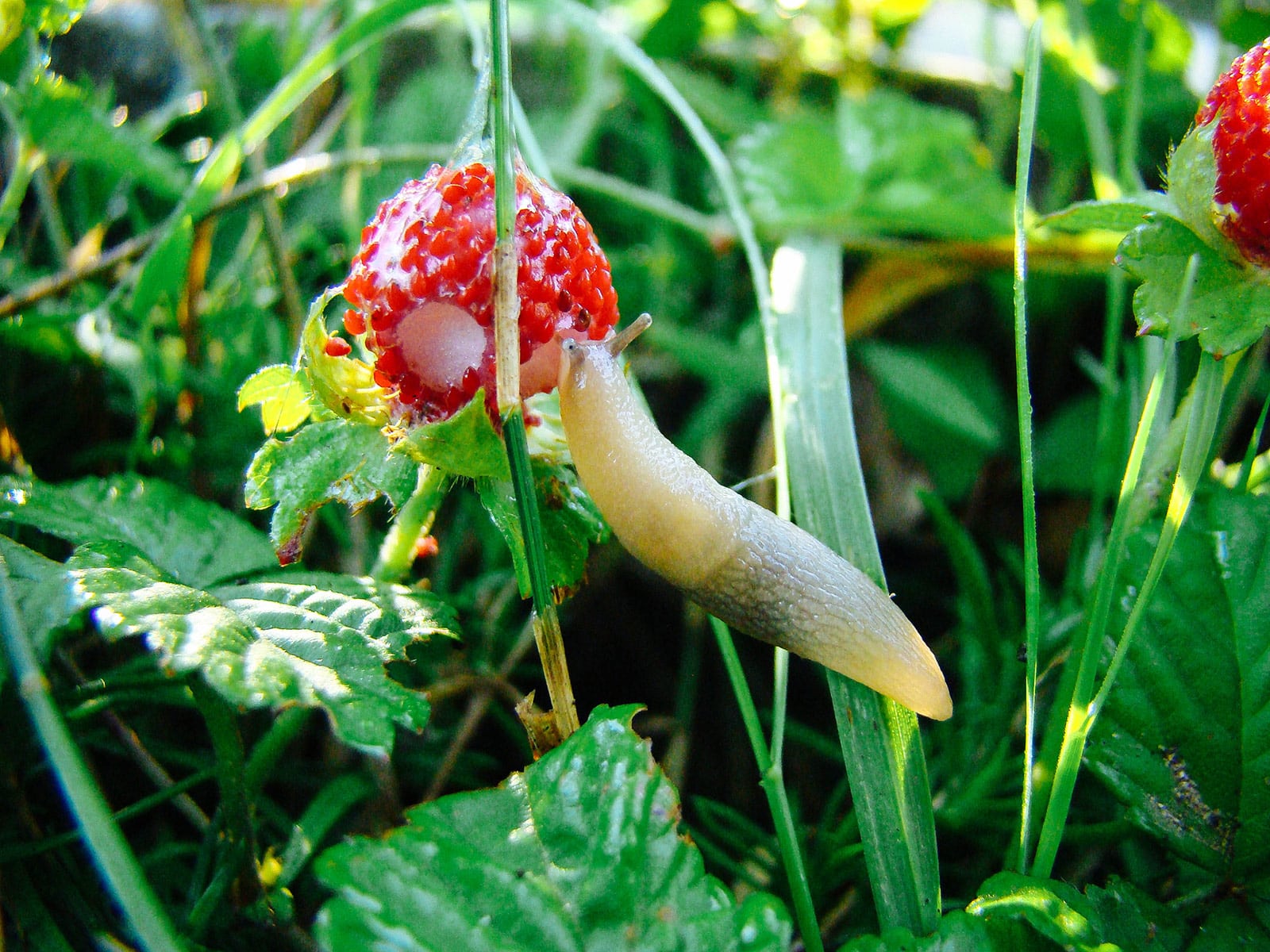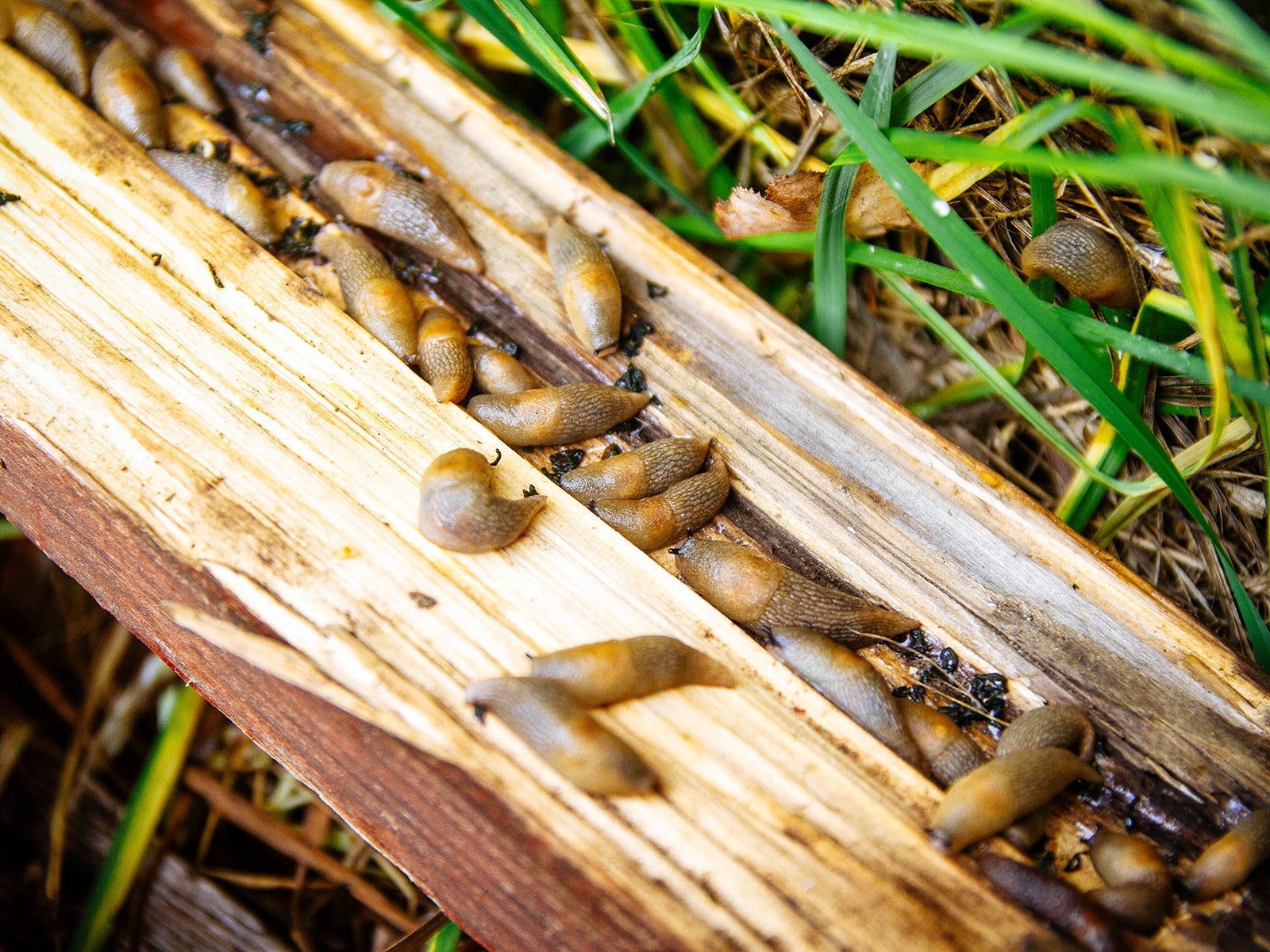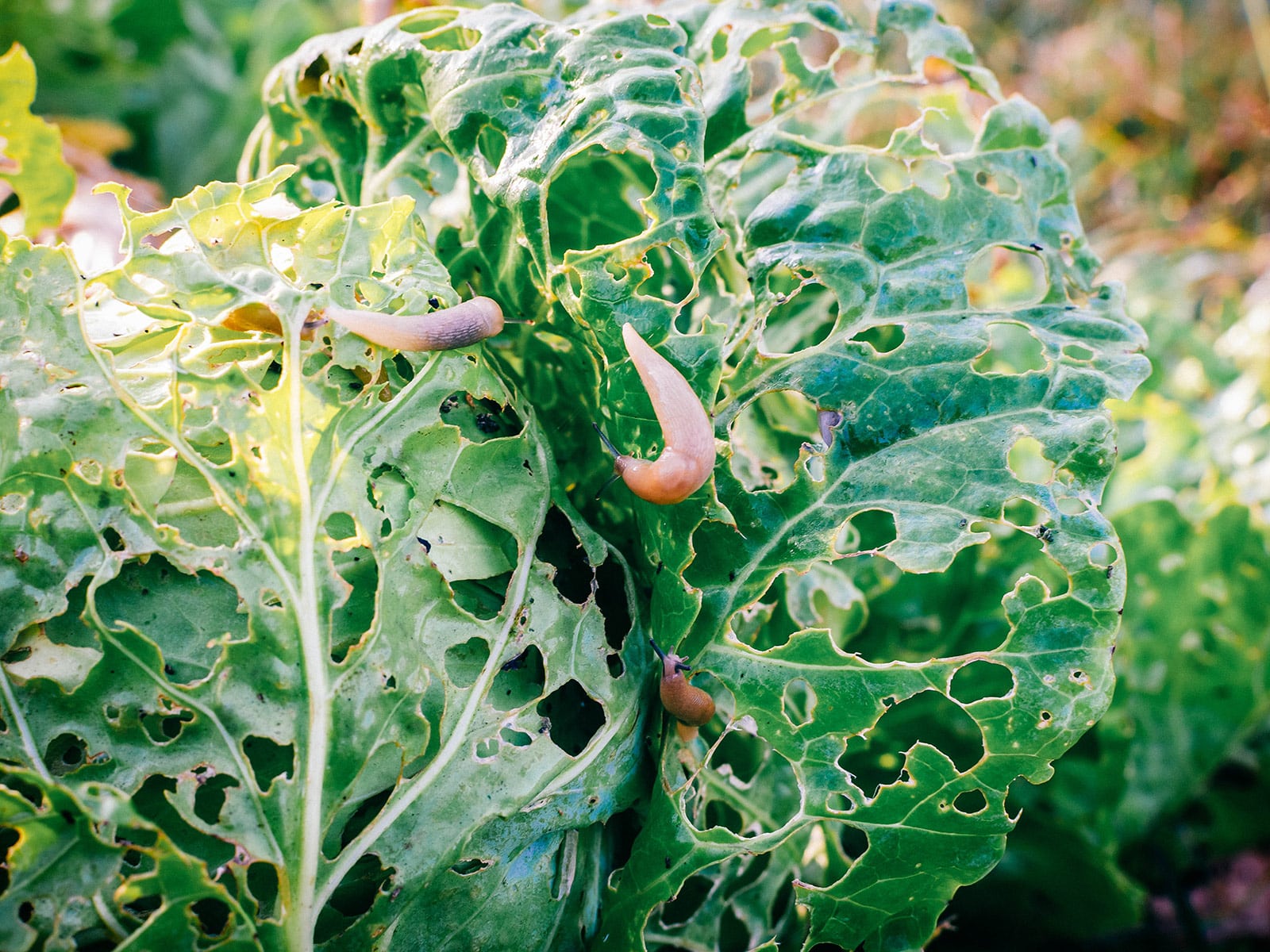If you have a garden full of succulent seedlings and leafy greens, you’ve seen the trail of dried slime and their gooey, tentacled bodies and wondered how something so slow-moving could do so much damage.
And you wouldn’t be alone in your thinking: Talk to any gardener or read any number of online forums, and you’ll find that slugs are an interesting (if not incredibly frustrating) pest because for how long they’ve been around (hundreds of millions of years!), we still haven’t found a non-toxic, economical, effective, and sustainable way to deal with them.
Homemade remedies abound for controlling slugs, and I’ve tried most of them. I’ve looked into the scientific literature to find out why something works or doesn’t work. And if you want to overcome slugs in your garden, there are three key facts you should know:
1. Slugs need moisture (both in the soil and in the air) to live.
That layer of slime helps protect slugs from drying up, and they only emerge from their mucus-lined holes in the ground if it’s dark, raining, or really damp. During dry spells, they (and their eggs) can lay in hiding for weeks—under stones, bushes, log piles, plant debris, or other organic matter—until favorable conditions return.
2. Slugs are attracted to the smell of yeast.
Slugs don’t necessarily like beer, even it looks like they’re taking a sip from your beer trap—they’re just fond of the yeasty smell (the malt). But you know what else has a yeasty smell and has been shown to be more effective?
Plain old bread dough!
3. Slugs are voracious but picky eaters.
It might not seem like it when you find holes in all your favorite plants, but slugs do have a preference for specific types of plants over others. They tend to go for dead or decaying plant material, which makes them important recyclers in the ecosystem.
If their population gets big enough, however, they’ll start to attack living plants. Even when there’s a veritable buffet in the garden, slugs will usually feast on certain species and leave others alone.

What they love: Bean leaves, beets, potato tubers, all brassicas (including cabbage, kale, broccoli, turnips, radishes, and Asian greens), basil, and strawberry fruits. This is not to say they won’t nibble some lettuce in your garden, but if they had a choice, they’d probably go after these other plants first (especially if they’re growing in partial to full shade).
What they avoid: Onions, garlic, tomato leaves, potato leaves, and most aromatic herbs (such as oregano, rosemary, lavender, and mint). In general, slugs don’t bother plants that get full sun (but obviously, if they’re hungry enough, they’ll eat anything).
What actually works to get rid of slugs
The problem with certain solutions that are often recommended for slug control is that they:
- May end up wreaking havoc on your garden even more (chickens and ducks)
- Are toxic to a variety of domestic and wild animals (metaldehyde)
- Can harm earthworms and dogs (iron phosphate)
- Can unbalance soil life (salt)
- Merely repel slugs and detour them to other plants (garlic sprays)
- May attract new pests like ants (bran)
- Aren’t effective when wet (diatomaceous earth, sawdust, and wood ash)
- Aren’t supported scientifically (copper tape)
- Or just plain don’t work (eggshells and coffee grounds)
A lot of articles also fail to mention the most important aspect of dealing with slugs: keeping them out of your garden in the first place.
After all, the best way to deal with a slug problem is to avoid attracting them.
So here’s what I do to control slugs naturally:
Keep things tidy
Remember that first key fact I mentioned (way up there) that you should know about slugs?
Slugs love to hide out during the day, so your first mode of attack should be to make your garden less inviting for them and remove all possible shelters near the plants you’re trying to protect.
That includes:
- Keeping grasses relatively short
- Keeping the areas around your plants weed-free
- Moving compost, mulch, and wood piles away from your garden beds
- Storing empty pots off the ground
- Relocating objects where slugs like to hide, such as boards, pavers, flagstones, or containers
- Placing garden beds away from wooden fences, hedges, and other bushy vegetation
Create brighter, drier conditions
Slugs cannot survive in dry environments, so it’s important to manage moisture levels in your garden (which also benefits soil and plant health).
You can do so by:
- Pruning low tree branches to let in more sunlight
- Dividing or thinning perennial plants to improve air circulation and allow the soil surface to dry out
- Pruning the lower leaves on your plants or stake them to keep foliage off the soil
- Watering plants in the morning so any surface moisture dries out before evening (when slugs are active)
Use their hiding spots against them
Since slugs hide out during the day, you can set out several flat boards (bonus points if they’re old and starting to rot), paving stones, or even just sheets of damp newspaper near your plants.

The next morning, lift the hiding spot, where you’ll likely see slugs congregating underneath. Smush them, cut them in half, or drown them in soapy water, then repeat for one to two weeks. This should put a significant dent in your slug population.
Let seedlings grow bigger before transplanting them
Seedlings have tender tissue, which slugs love. This makes them super vulnerable to slug damage and because of their small size and limited resources, they don’t often recover from an attack.
To give new seedlings the best chance at life, wait until they develop a little more fully before transplanting them outside. Make sure you harden off the seedlings properly to minimize stress.
Keep plants healthy
Speaking of stress, if your plants are weak and unhappy, they become easy targets for all pests (including slugs).
What kinds of things cause stress? Inconsistent watering, over- or underwatering, extreme temperatures, too little sun, too much fertilizer, excessive pruning, overcrowding, root disturbance, and the list goes on.
Healthy plants are better able to withstand slug damage because they have high turgor (the inner pressure that gives plant tissue rigidity) and plenty of energy to recover from a nibble by a passing slug.
Be sure to monitor the health of your plants (especially young plants) throughout the growing season to keep them productive and resilient.
Hand-pick slugs after sunset
With a flashlight and a good amount of determination, you can control slugs simply by hand-picking them in the evenings when they’re most active.

This is particularly effective in spring when many slugs are youngins, but it’s worth getting out there any time you see signs of slug damage. Hand-picking slugs every night for one to two weeks will stop the rise in population and keep their numbers more manageable in the garden.
Set out yeast traps
I say yeast instead of beer because in my experience, and based on a recent study, bread dough (or even just a slurry of flour, water, and yeast—like a runny dough) is much more attractive to slugs than beer.
But if all you have is a cheap can of beer? By all means, use it! The more yeasty smelling, the better.
(In fact, Colorado State University ran an experiment back in 1987 to see if slugs preferred one brand of beer over another. They found that the most effective beer wasn’t even a beer at all, but a now-defunct non-alcoholic brand called Kingsbury Malt Beverage. Budweiser and Michelob came in close second and third, however.)
Disclosure: If you shop from my article or make a purchase through one of my links, I may receive commissions on some of the products I recommend.
Two important things to keep in mind are:
1. Slug traps only work if they actually trap the slugs and keep them from crawling back out.
So the standard yogurt cup or pie pan-type trap isn’t really effective—you need to use a closed container with holes cut in the sides to lure them in. They then fall into the trap and drown before they can escape.
I recommend a commercial beer trap like this one that keeps water out. (You can fill it with bread dough instead of beer.)
What to buy
2. You need to place several traps near susceptible plants.
Slugs can smell yeast from about 3 feet away, so space your traps no more than 3 feet apart for maximum efficacy. Empty them at least once a week (depending on how many slugs you catch) and refill the trap with fresh bread dough or beer.
Use an essential oil spray
One solution that was tested in a greenhouse setting is the use of essential oils, which can be toxic to slugs (but safe for plants). This study found that when slugs were added to container plants and sprayed with essential oil emulsions, they faced 97.5 percent mortality (a result comparable to metaldehyde). Thyme and spearmint oils were particularly lethal to slugs.
You can try this ready-made formula, which contains rosemary, sesame, peppermint, thyme, cinnamon, and garlic oils to stop slugs from eating your plants.
What to buy
When you combine a few of the methods above to control slugs in the garden, you’ll be able to bring their populations down significantly. The goal is not to eliminate them entirely (since they do attract beneficial predators and serve as decomposers) but to make them more manageable so they stick to eating your garden debris—and not your plants.
















Re: slug traps, a mention of a slurry of flour, yeast, water…what ratio?
Appreciate any tips !!!!!
Its in the link “recent study”: in essence –
2 pkts active dry yeast
500ml flour
500ml water
Mixed and fermented for 2 days
I have incredible success with yeast into flour and mixed to the level of pancake dough that pours easily into lids or lids in traps. Wish I could send a picture of lids filled to the top and overflowing with dead slugs. slugs do not crawl out of this mix.
I started this process last year thanks to the yeast tip from Garden Betty.
I never pass by a Post with your great tips.
Thank You.
Hi there,
Thanks for all of the great ideas!
The one thing I do when I transplant plant my seedlings is put finely crushed eggshells around them……this feels like broken glass on their little bellies. Definitely works!
Thank you!! Beer does work but there isn’t a container big enough! The live ones crawl over the dead ones. 🤬🙄